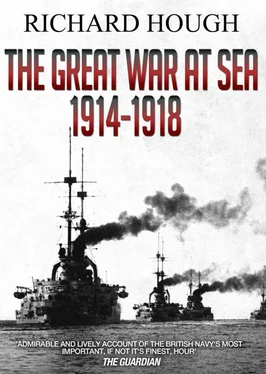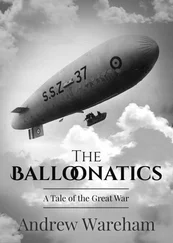Soon after the completion of the Dreadnought , others of her kind even larger, more expensive, and more powerful were ordered by three South American republics, by Spain, Italy, Greece, and Turkey, as well as by the major powers. In Japan, newly built shipyards constructed some of the finest men o’war of their time. The United States Navy, so insignificant that it had been openly challenged by Chile in 1891, expanded rapidly and began ordering battleships.
Before the end of the nineteenth century the growth of navies all over the world was already shaping the direction of twentieth-century history. Nowhere was the course more sharply and uncompromisingly delineated than in Germany; nowhere were the lessons of Captain Mahan studied more zealously.
The rise of the German Navy from the early 1890s to 1914 was a remarkable achievement. A navy demands a multitude of special skills both in the construction of ships and the training of the men to serve in them. The Germans lacked experience equally in the manufacture of armour-plate and heavy naval ordnance as in gunnery, signalling, and manoeuvring a large number of ships at sea. Nor did they possess any naval traditions or history. They were starting from the first riveter working on the first strake and the first gunlayer behind the sights of an 8.2-inch naval gun in a choppy sea. But the Germans learned fast and – like the new United States and Japanese navies – largely from the British Navy.
The inspiration for the German Kriegsmarine came from the Emperor himself, Kaiser Wilhelm II. He was a ruler whose withered left arm was matched by a flawed mind, who laboured under grievances all his life, the most dominant in the early years of his reign being envy for the navy of his grandmother, Queen Victoria. It caused the Kaiser real suffering not to be supreme. He boasted the greatest army in the world as well as the grandest personal uniforms and decorations. When he saw his nephew enjoying Cowes Week, and winning races there, the Kaiser set about building the finest ocean cutter in the world and applying himself with earnest seriousness to the art of racing. After expressing his complaints about the handicapping, his will to win prevailed until the future Edward VII could bear it no longer: ‘The regatta at Cowes was once a pleasant holiday for me,’ he remarked sadly, ‘but now that the Kaiser has taken command there it is nothing but a nuisance.’ And he never went again.
Kaiser Wilhelm did not care to be seen in an inferior Royal Yacht to his grandmother’s so he ordered a bigger and grander one. Wherever the Kaiser sailed in his glittering Hohenzollern he saw evidence of the dominant power of Britain at sea. He resented deeply the Royal Navy’s size, strength, and apparent efficiency. He resented the respect for and acquiescence to the Royal Navy by the rest of the world, and Britain’s pride in the service which he saw as no more than arrogance.
The Kaiser’s partner who shared and encouraged his ambition was Alfred von Tirpitz, who was ten years older (born 19 March 1849) and had originally served in the old and unesteemed Prussian Navy. Tirpitz showed no special distinction as a sailor in this minor service, but revealed himself as a brilliant and ambitious administrator and political manipulator. He strongly attracted the attention of the Emperor, and became Secretary of State for the Imperial Navy in June 1897, a date which marks the birth of the mighty High Seas Fleet.
Tirpitz needed all his Machiavellian qualities, and all the Kaiser’s powerful support, to persuade the Reichstag to pass the first of his German Navy Laws in 1898 against the liberal-pacifist element on one side and the Prussian Army clement which was equally hostile. This law provided for the considerable expansion of the service, and was followed by a second in 1900 of a much more ambitious nature. It called for a fleet including 38 battleships, 20 armoured cruisers and 38 light cruisers – a fleet which he justified in these momentous and threatening words:
In order to protect German trade and commerce under existing conditions only one thing will suffice, namely, Germany must possess a battle fleet of such a strength that even for the most powerful naval adversary a war would involve such risks as to make that Power’s own supremacy doubtful. For this purpose it is not absolutely necessary that the German fleet should be as strong as that of the greatest naval Power, for, as a rule, a great naval Power will not be in a position to concentrate all its forces against us.
These words were heard with dismay in Britain. Germany’s colonial expansion in Africa and the East – the Weltpolitik – and hostile events such as the despatch of the provocative anti-British ‘Kruger Telegram’ of 1896, and the Anglophobic chorus conducted by German statesmen and the Press during the Boer War, all combined to cause alarm and a massive reappraisal of the naval position of Britain and her Empire at the end of the old century.
The death of Queen Victoria on 22 January 1901 caused conflicting shocks of grief and disbelief that the old lady was not after all immortal. Her eldest, once recalcitrant and much abused son succeeded at a moment in the nation’s history of anxiety and the need for far-reaching decisions. France, Russia, and Germany were all hostile. No one approved of Britain’s war against the Boer farmers, and suspicion and disapproval of her imperial power and stance were widespread. Now her Navy was being directly threatened by the most powerful military nation in the world.
As one writer was to put it, ‘Without the supremacy of the British Navy the best security for the world’s peace and advancement would be gone. Nothing would be so likely as the passing of sea-power from our hands to bring about another of those long ages of conflict and returning barbarism which have thrown back civilization before and wasted nations.’ (3)Between them, Kaiser Wilhelm II and the head of his navy had brought about an end to the Pax Britannica even before the first keel of the first of the new German battleships was laid down.
For Britain, the end of the old century and the death of the old Queen marked also the end of isolation. The accession of that most gregarious of monarchs, Edward VII, could not have occurred at a more appropriate time for the nation. Britain was in need of friends.
Within a few years, the Anglo-Japanese Treaty of Friendship (30 January 1902) and the Entente Cordiale (8 April 1904) with France, lovingly prepared by Edward VII, permitted Britain eventually to withdraw the greater part of her naval strength from the Far East and the Mediterranean, and concentrate her battle fleets in home waters. This was just what Tirpitz had declared Britain would not be able to do.
Would these steps be sufficient to meet the growing threat from across the North Sea, which had already been renamed in German atlases ‘German Ocean’? Were the matériel and the fighting efficiency of the Royal Navy equal to the task?
The Royal Navy at the outset of the twentieth century was like a rich, vain old man, swollen with self-confidence and living on the memory of past glories. He cannot move quickly nor see very well. He is a gregarious clubman but has as little regard for modern times and trends as he has for those outside his circle.
The best that can be said of the Royal Navy in 1904 is that it had known worse days quite recently. In the early 1880s the service could look back forty years without pride on a record of ultra-conservatism. As far as the sailors were concerned they were fed, treated, and paid as if Nelson were still their commander-in-chief. Hardships were made tolerable by companionship and the ever-liberal rum ration. The officers were indifferently educated, unimaginative, their style and conduct ruled by elaborate protocol, custom, and tradition. For them the Navy was as exclusive as a Guards regiment. In war they would doubtless have performed with all the valour of their ancestors. In peace, for decade after decade, the old brotherhood which had linked them in battle with the lower deck had withered.
Читать дальше












